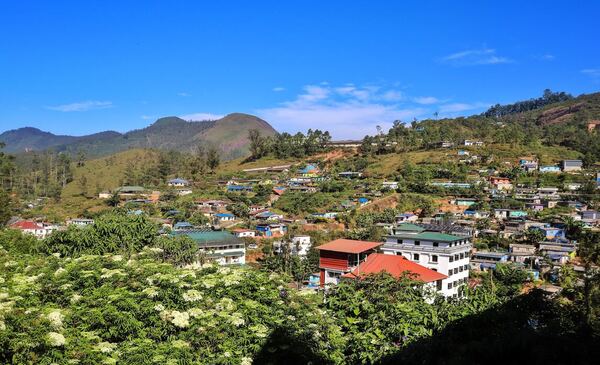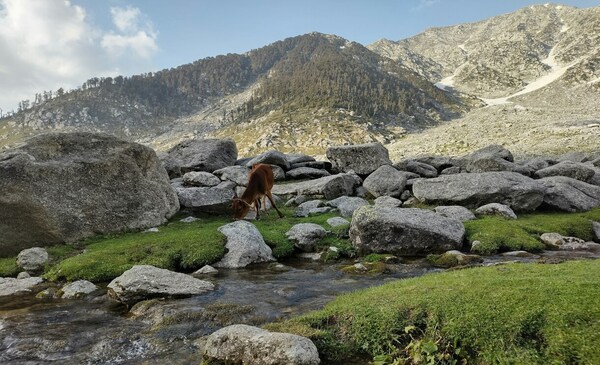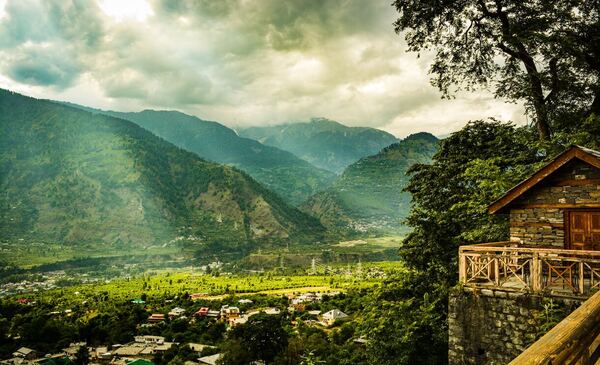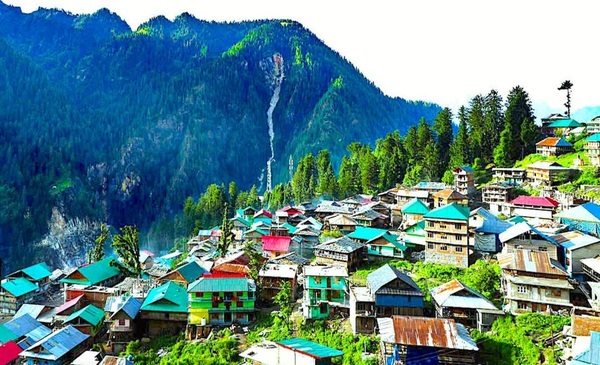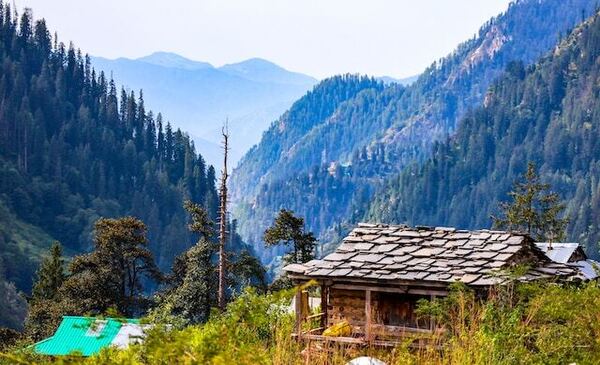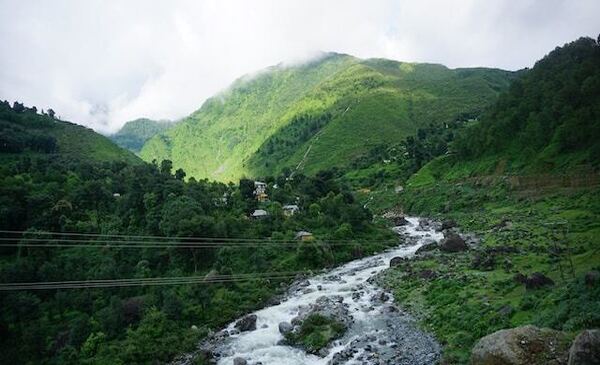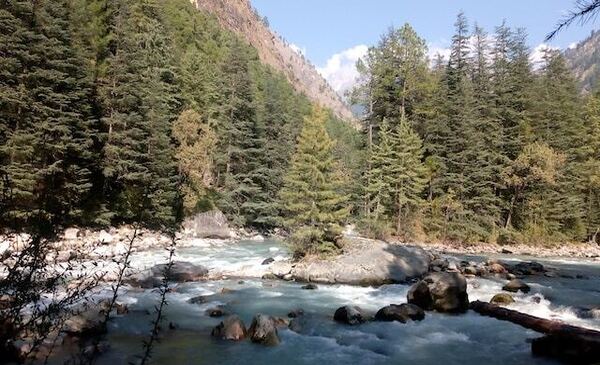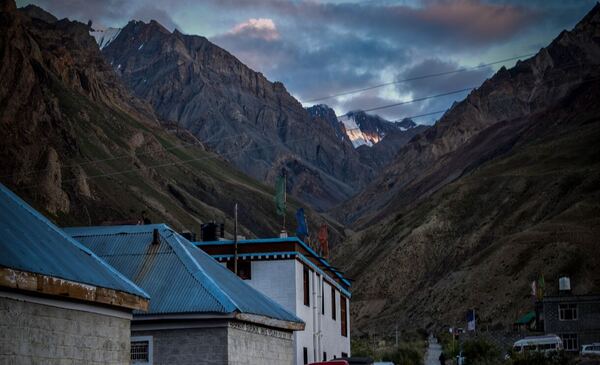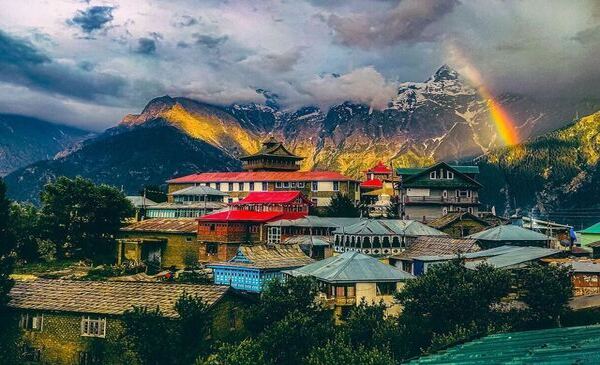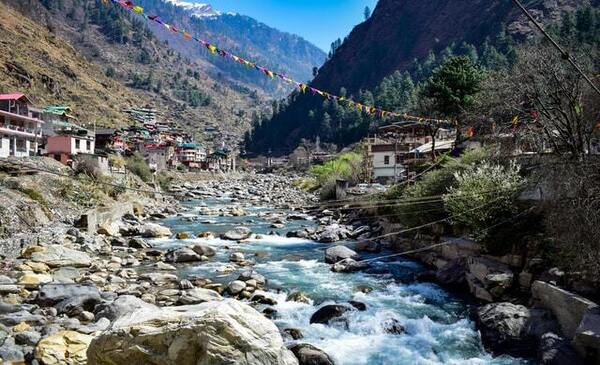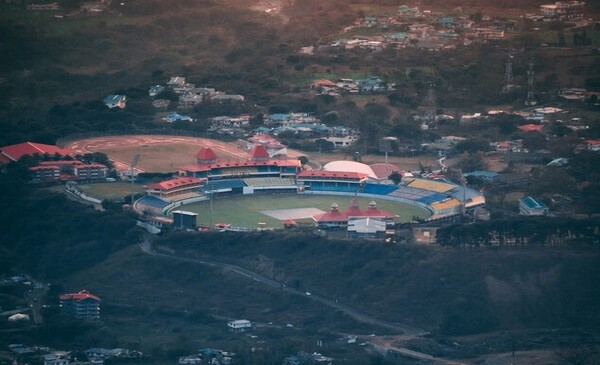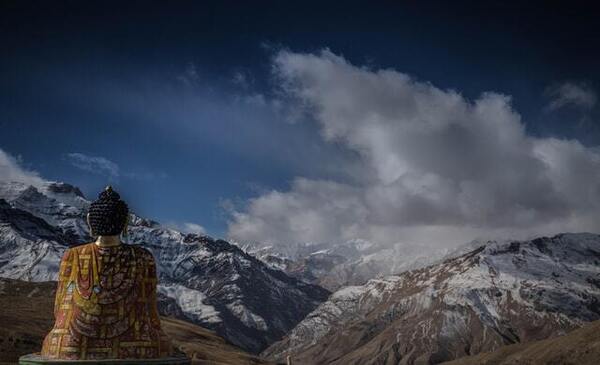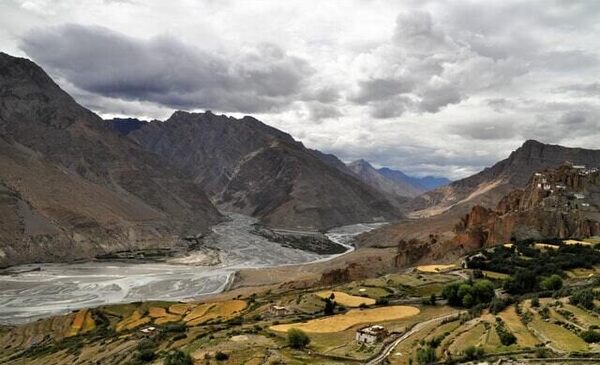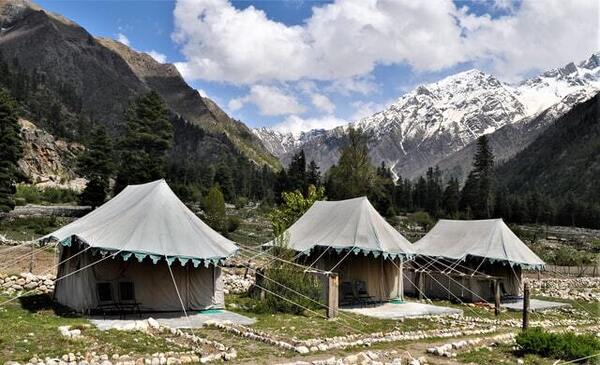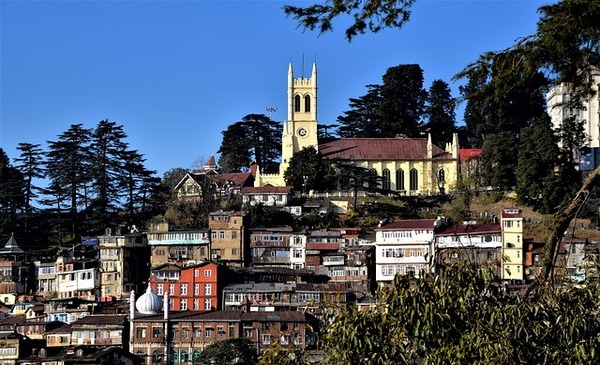Leh Manali Highway
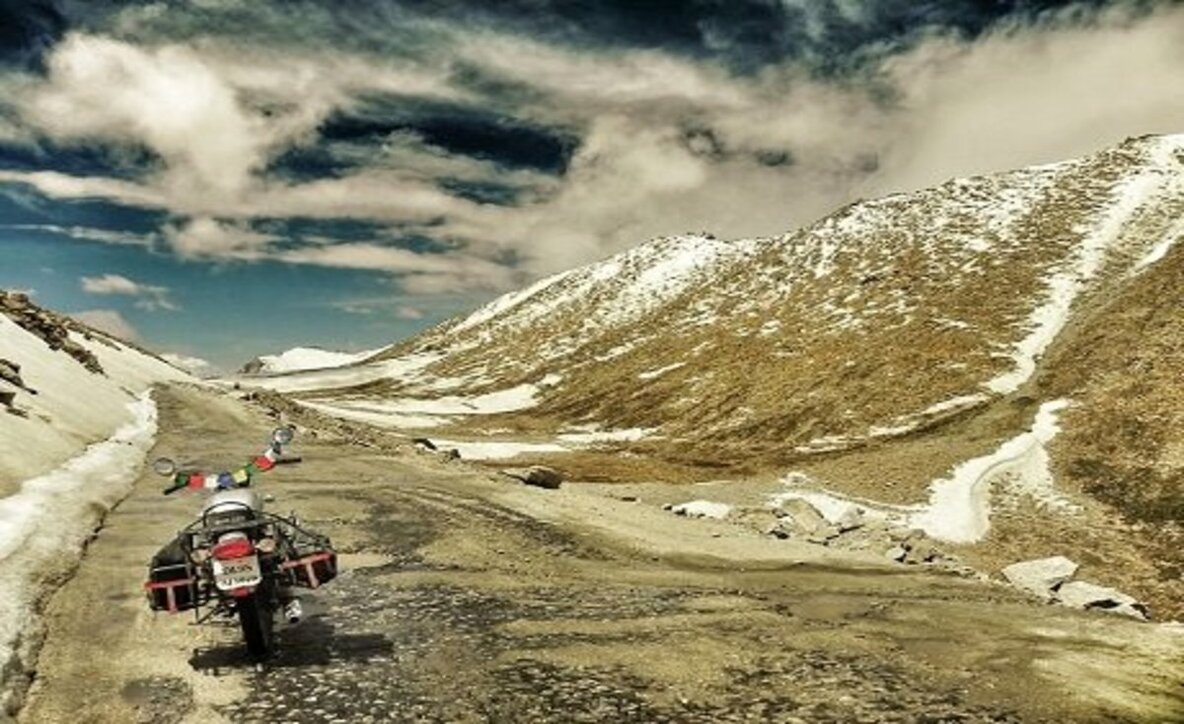
Manali is a city, nearby Kullu city in Kullu district in the Indian state of Himachal Pradesh. It is placed in the northern ending of the Kullu Valley, shaped by the Beas River. The city is placed in the Kullu region, just about 270 kilometres (170 mi) north of the state capital of Shimla and 544 kilometres (338 mi) northeast of the national capital of New Delhi. With a populace of 8,096 citizens recorded in the 2011 Indian survey Manali is the begin of an especially old traffic way throughout Lahaul (H.P) and Ladakh, above the Karakoram Pass and onto Yarkand and Hotan in the Tarim Basin of China. Manali is a famous traveler’s location in India and serves as the entry to the Lahaul and Spiti district as well as the city of Leh in Ladakh.
Demographics
Manali has grown-up from a trading village to a tinny city. As of the 2011 survey of India, its population was 8,096. In 2001, Manali had an official populace of 6,265. Males constituted 64% of the populace and females 36%. Manali had a normal literacy speed of 74%, male literacy was 80%, and feminine literacy was 63.9%. 9.5% of the populace was under six years of age.
Manali in May 2022
Weather
Snowfall in Manali
Manali features a subtropical highland weather with warm summers, moderately cold winters, and an elevated diurnal heat difference. The temperatures variety from −7 °C (19 °F) to 30 °C (86 °F) over the year with the most recent day journey 30 °C (86 °F) and the coldest day going under −7 °C (19 °F). The standard temperature in summer is between 10 °C (50 °F) to 30 °C (86 °F), and among −7 °C (19 °F) to 15 °C (59 °F) in the winter.
View of Himalayas from Manali
Monthly rainfall varies among 31 mm (1.2 in) in November and 217 mm (8.5 in) in July. On standard, some 45 mm (1.8 in) of rainfall is received in winter and spring months, rising to some 115 mm (4.5 in) in summer as the monsoon approaches. The standard total yearly rainfall is 1,363 mm (53.7 in). Manali experiences snowfall mainly among December and the starting of March.

Transport
Air
The nearby airport Kullu–Manali Airport (IATA code KUU) is at Bhuntar city in Kullu. The airport is also well-known as Kullu-Manali airport and has added a kilometer-long runway. Air India has normal flights to the airport from New Delhi.
Helicopter taxi service
Pawan Hans, the Government charter charity, provides helicopter-taxi service connecting Shimla to Chandigarh, Kullu, Kangra and Dharamshala.
Road
Manali can be at home from Delhi by national highway NH 1 up to Ambala and from there NH 22 to Chandigarh and from there by national main road NH21 that passes throughout Bilaspur, Sundernagar, Mandi and Kullu city. The road distance from Chandigarh to Manali is 310 km (190 mi), and the entirety distance from Delhi to Manali is 570 km (350 mi). Bus services are accessible from HRTC (Himachal Road Transport Corporation), HPTDC (Himachal Tourism Development Corporation), and personal operators.
Railway
There is no close railhead accessible near to Manali. The nearby wide gauge railheads are at Una 250 km (155 mi) apart, Karipur 268 km (167 mi), Kalka (275 km (171 mi)), Chandigarh (310 km (193 mi)), and Pathankot (325 km (202 mi)). The nearby narrow measure railhead is at Joginder Nagar (147 kilometres (91 mi)). The Kalka–Shimla Railway is a nostalgic narrow-gauge way culminates at the situation capital of Shimla wherefrom one has to tour by road to Manali.
Environmental concerns
Manali has witnessed a spell of movement connected to hydroelectric power and tourism. Accidental and rampant building has lead to harsh reduction of forest and toxic waste of river bodies, all-along with trash being disposed of on the part of the mountains. There has been a failure of habitation to a variety of type of fauna, not restricted to the Himalayan Monal, by the way the state bird of Uttarakhand.
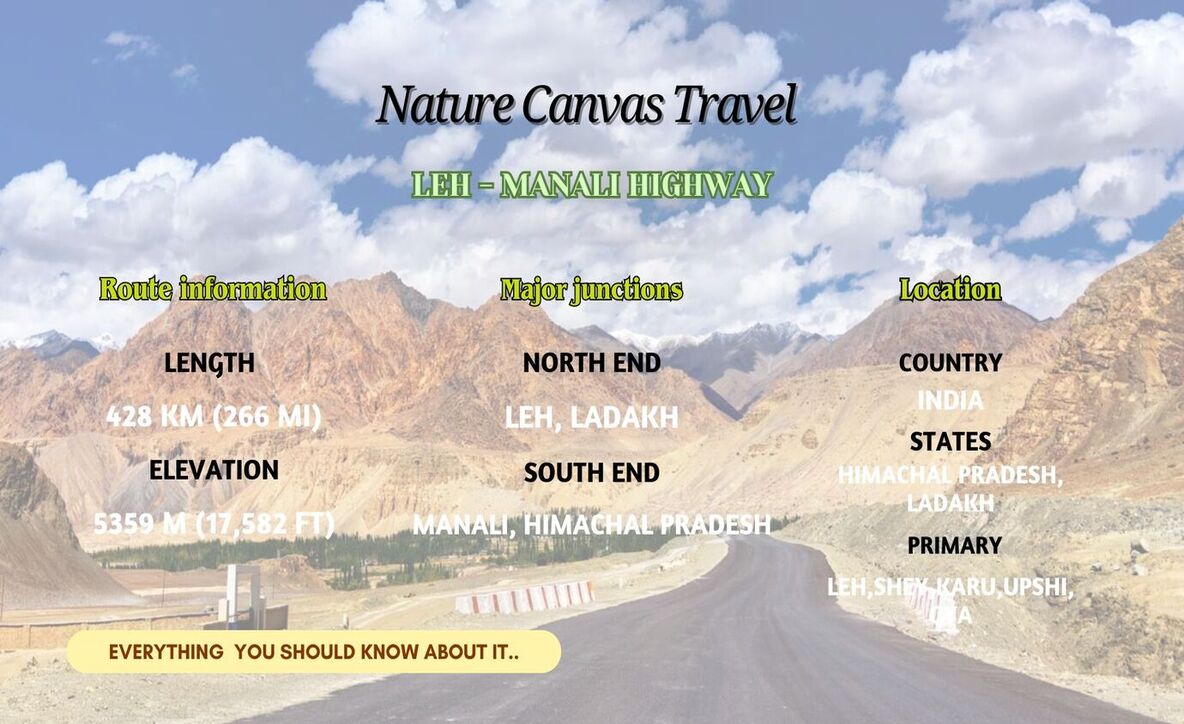
Route of Leh-Manali Highway
The whole measurement lengthwise of the highway is approx 428 km (266 mi). It has 177 km (110 mi) in Himachal Pradesh as the extent in Himachal Pradesh is edited by about 45 km (28 mi) later than the opening of the Atal Tunnel avoiding the Rohtang Pass, and 251 km (156 mi) in Ladakh. The position line is at Sarchu
Location State Altitude Distance Remarks
- Manali Himachal Pradesh 1,950 metres (6,400 ft) 0 kilometres (0 mi) It is the starting peak of way.
- Sissu Himachal Pradesh 3,130 m (10,270 ft) 41 km (25 mi) the way from Manali to Sissu runs via Palchen-Solang Valley road, then throughout Atal Tunnel bypassing the Rohtang pass. Additional, the distance from Manali to Gramphu via Atal Tunnel is only 47 km for Spiti valley jump tourisers. There is a helipad at Sissu with repair to Manali in the winter.
- Tandi Himachal Pradesh 2,570 m (8,430 ft) 22 km (14 mi) Tandi is at the foundation of a river valley, where the Chandra River and the Bhaga River (flowing from the north) combine to form the Chandra-Bhaga river (which becomes the Chenab downstream in Jammu region). Cross the Bhaga river over the overpass towards the correct, take the correct twist at the fork, and the road once more starts mountaineering.
- Keylong 3,080 m (10,100 ft) 8 km (5.0 mi) Keylong is District HQ of Lahaul and Spiti district.
- Jispa 3,310 m (10,860 ft) 22 km (14 mi) Jispa is a village where two nullahs (small streams) link the Bhaga River.
-
Darcha 3,360 m (11,020 ft) 6 km (3.7 mi) all travelers have to list at the police check post here.
- Zingzingbar 4,270 m (14,010 ft) 25 km (16 mi) Zingzingbar is the South gateway for the planned Baralacha La Tunnel. The steep ascent to Baralacha La starts at Zingzingbar.
- Bara-lacha la 4,850 m (15,910 ft) 22 km (14 mi) It is a steady climb. A stream (from a glacial melt) flows across the highway just earlier than Zingzingbar. It is advisable to cross the stream before noon because the stream of ice-cold water increase as the heat rises. If the run of water is also great for a motor vehicle to crosswise, or if the climate worsens way to Baralacha La, turn back to Zingzingbar or Darcha, and look for lodging earlier than trying on the next day. The 130 km drive from Zingzingbar to Pang is the toughest division of the trip on the highway and a terrible at times. In the perfect of the season, without any obstruct and transfer jams, it can take up to 5-6 hrs to wrap this make bigger with at least one stop en way. Approximately 35 kms of stretch on each side of Sarchu has been doubling-up laned and is in good situation currently.
- Killing Sarai 13 km (8.1 mi) it is a steady descent. Killing Sarai is the North doorway for the planned Baralacha La tunnel. The Bhaga River and the Chandra River create from melting snow at differing sides of Baralacha La, the previous flowing southwest and the later flowing first southeast and then northwest to combine at Tandi.
- Sarchu 4,200 m (13,800 ft) 20 km (12 mi) Sarchu is a military base and has a police check post. It is the border among Himachal Pradesh and Ladakh. Schedule at the police check post here.
- Pang Ladakh 4,650 m (15,260 ft) 76 km (47 mi) It involves mountaineering 500 m through the Gata loops (21 hairpin bends) at 4,190 m (13,750 ft) elevation and traversing through Nakee La at 4,739 m (15,547 ft) and Lachulung La at 5,065 m (16,616 ft) elevation.
- Upshi Ladakh 61 km (38 mi) the highway crosswise the Indus river to arrive at Upshi village on the north.
- Karu 14 km (8.7 mi) later than crossing the Indus river at Upshi, the highway bears not here for Karu. The exact twist is an antique trading road heading east toward Pangong Lake and Tibet. There is a helipad on this road.
- Leh 3,500 m (11,500 ft) 34 km (21 mi) Staying to the absent and following the Indus River leads toward Leh. There is one more turn-off to the correct that goes to Shyok, Pangong Lake, and Tibet.
Road surface
Fast-flowing water eroded the main road on the extra plains.
The Leh-Manali highway is normally two lanes wide (one lane in each direction) without a road partition but has only one or one and a partially lanes at some stretches. Snow and rain can make the highway mushy or too slimy to tour. Past rainfall can also make tour hazards. It has over a dozen Bailey bridges and all of them are now being upgraded to two-lane steel bridges. The highway crosses so many streams of ice-cold water from snow-covered mountains and icy melts without a bridge and it require driving skill to consult fast-flowing streams. The highway has so many injured stretches and under-maintained portion, where even a small rainfall can activate risky landslide. The road class is derived from Zingzingbar to Pang and one has to drive suspiciously as elevated rate can reason embarrassment.
Climate
Yaks in More plains
Ladakh is a chilly semi-arid desert. It is cold all along the main road even in summer (May onwards); the days are temperate in vivid sunshine but the nights are extremely chilly. Glow woolens are necessary in the day and wide woolens are necessary at night. There is very little precipitation among Darcha and Leh even in the monsoon season in July–September as the whole area lies in rain shadow.
Earlier Route
The Rohtang Pass becomes impassable in winter.
1: Manali (altitude 1,950 m (6,400 ft)) to Marhi at 3,300 m (10,800 ft) height 33 km (21 mi). It is a stable rise.
2: Marhi to Rohtang Pass at 3,980 m (13,060 ft) height 18 km (11 mi). It is a stable mount.
3: Rohtang to Gramphu at 3,200 m (10,500 ft) height 15 km (9.3 mi). It is a stable drop. The correct twist (towards east) at Gramphu leads to Spiti valley, Batal, Kunzum La and Kaza on a road all along Chandra River that is unpaved awaiting Kunzum Pass and further than.
4: Gramphu to Koksar, the first village north of Rohtang Pass 5 km (3.1 mi). Foreign nationals have to show their passports with valid visas at the police force check post at this point.
5: Koksar to Sissu at 3,130 m (10,270 ft) elevation 15 km (9.3 mi). The highway runs all along the gone (south) bank of the Chandra River, with a stunning waterfall on another part of the stream.
Later than this, there is the major way from Sissu as mentioned on top of.
Travel time
Later than the opening of the Atal Tunnel, the trip from Manali to Leh usually requires one during the night stay way (During night accommodation are described under). Tour time is random while the climate and road situation can modify unexpectedly. However, it is now achievable to cover up the whole trip from Manali to Leh in 14-16 hours in a single day, if there are no road blockades and transfer jams in way.
The climax tour time is during May-June and September-October when travelers visit Atal tunnel, Rohtang pass, and Lahaul valley. Most of the domestic travelers come back to Manali on the same day. Himachal Road move Corporation (HRTC) and Himachal Pradesh sightseeing growth Corporation (HPTDC) operate buses that tour the whole highway in two days. Buses begin from Manali at 4 am awaiting 6 pm. The tour time from Manali to Keylong is at the present just about 2 hours via the Atal tunnel. Personal four-wheel drive taxis are accessible. Shared taxis are despicable as they charge per person, but they might be filled of restricted populace. The travelers cannot stop also a bus or a common cab for seeing the sights. So Many bikers tour from Manali to Leh and another spots in Ladakh on motorcycles, normally in an assembly.
Fuel stations
Before, there was no petroleum station for 330 kilometres (210 mi) among Tandi and Karu. Now, a new petroleum station at Keylong has turned into operational while September 2021. Motorists and bikers must fill up at the begin of this make bigger. Motorcycles and vehicle with tinny tank must take extra energy in cans. In a tragedy, fuel may be accessible at villages and campsites way (Jispa, Zingzingbar, Sarchu, Pang, etc.), but this oil must be adulterated and expensive.
Altitude sickness
At elevated altitudes, the air is thin and contains less oxygen. Acute mountain sickness is possible; whose symptoms take in headache, nausea, dizziness, and vomiting. It can be fatal. A tourister arriving by air from lower terrain should acclimate to the high altitude by staying at least one night at the starting point (say, Manali), and plan to stay over at either Keylong, Jispa or Darcha earlier than rising to the highway's maximum passes and plains later than Darcha. Travelers must minimize the time spent at elevated altitude and so not stay over at Sarchu or Pang. They must take chocolates, glucose, or another high-energy food on the trip.
References
-
- Defence ministry clears the BRO tunnel under Shinkun La in Ladakh, Hindustan Times, and 19 May 2021.
- Wangchuk, Rinchen Norbu (5 February 2018). "Here's the past at the back one of the Jaitley's main budget announcement". The improved India. Retrieved 5 September 2021.
- Series U502, U.S. Army Map Service, map of quadrant ni-43-12
- "Hundreds stranded on Manali-Leh highway". The Hindu. 23 September 2008. Archived from the rare on 26 September 2008.
- Another. "Atal Tunnel opens". The Tribune. Retrieved 5 October 2020.
- "All you need to know about Atal Tunnel: Manali to Leh by road, 365 days a year". Auto.hindustantimes.com. 2 October 2020. Retrieved 5 October 2020.
- Dheeraj Sharma (15 July 2019). "Manali to Leh Bus Service - Timings, Rates & FAQs". DevilOnWheels.com. Retrieved 22 July 2019.

